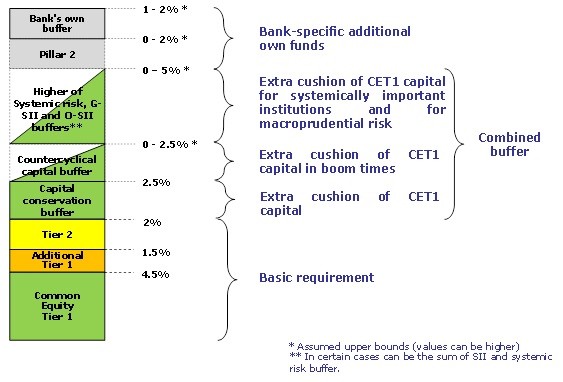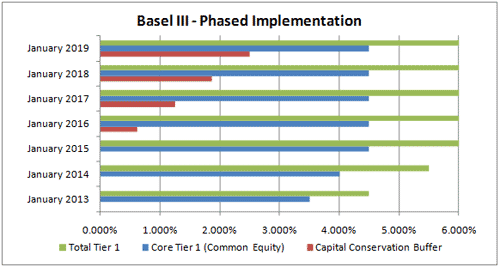Basel III leverage impact on African Banks
Post on: 14 Май, 2015 No Comment

The “Revised Basel III leverage ratio framework and disclosure requirements consultative document” was published in June 2013 for comments by 20 September 2013. One can argue about the relevance of such a ratio for bank risk supervision, but that is not my intent in these comments. I only wish to analyse the potential impact of that ratio for emerging banks and markets.
The proposed leverage ratio is defined as the Capital Measure (the numerator) divided by the Exposure Measure (the denominator) expressed as a percentage and calculated on the basis of the average of the 3 month-end ratios of the quarter. The Capital Measure is the Tier 1 capital (as per the BIII standards) and the Exposure Measure is the accounting measure of the bank’s on-balance sheet and off-balance sheet exposures (without netting), net of specific provisions and valuation adjustments (e.g. credit valuation adjustments).
The exposures are defined in detail in the proposed Basel III document, but there are no fundamental problems and all the data should be readily available, with some simple calculations to estimate the exposures on derivatives.
The disclosure requirements are simple and just require transparency by giving the detail of the calculation and amounts as per the template reports included in the Basel proposal.
So we can be reassured that this will not require and extensive systems development and that all banks with a minimum accounting capability and access to financial data will have no problems in calculating the ratio.
The problem for some of the Western banks is not in the calculation but in the respect of the norm. The regulatory leverage is of minimum 3% i.e. the Tier 1 Capital must exceed 3% of the total exposures; in other terms the maximum exposure is limited to 33.33 times the Tier 1 capital. The current limit and definitions were confirmed and are a regulatory requirement tested by the authorities during the parallel run from January 2013 to January 2017. Throughout that period the minimum ratio remains at 3%. The definitions will be finalised in the first half of 2017 and integrated in Pillar 1 as of 1 January 2018.
Leverage analysis in African markets
The impact of the Leverage ratio to the banks in Africa should be limited as they usually have low non-risk adjusted leverage. To illustrate that I used the Zambia financial data of all the banking sector, as published by the Bank of Zambia. As of March 2013 the consolidated leverage was 10.04% versus the minimum 3 %. This is good news as it will allow these banks to manage the much more difficult regulatory limit represented by the “Revised Liquidity Coverage Ratio and liquidity risk monitoring tools” published by the Basel Committee in January 2013.
A quick analysis of all the other African markets confirms this positive news. Remember this is a non-risk adjusted leverage measure. The same is not true when looking at risk adjusted measures of capital adequacy.
Liquidity risk: LCR impact to emerging markets
The calculation of the Liquidity Coverage Ratio under stress is much more complex to calculate. To review all the rules would not be possible in this short analysis. They require readers to refer to the Basel document, readily available on the BIS site (www.bis.org).
The actual ratio is simple, as it represents the proportion of High Quality Liquid Assets or HQLA (those that can be sold i.e. transformed into cash, at short notice with imposed stressed haircuts and within markets that have some fundamental depth and price efficiency) versus the a 30 days stressed Net Cash Outflow.
The actual stress hypothesis, haircuts and cash-in and cash-out flow hypothesis represent the difficulty and modelling complexity. It requires access to granular contract data to allow appropriate contract segmentation and application of the stress hypothesis. All banks with adequate data architectures and technology can easily develop the calculation model, with enough drill down and drill through functionalities to report the ratio and more importantly analyse and manage the different components of the HQLA and Net Cash Outflows.
The real problem is not the modelling. The real problem lies in the availability of HQLA and in stability of the banks’ cash flows. In advanced financial markets, banks have had to find profitability in many structured complex products that have low liquidity and have not focused enough on stable funding (over reliance on corporate and interbank short term funding), resulting in large potential discounts of HQLAs and sever potential net cash out-flows.
The Banks and local regulators of the advanced markets have lobbied the Committee to bring the initial LCR limit down from the initial 100%, during a transition implementation period. The Basel Committee has agreed to impose a step-up minimum LCR requirement:
1 January 2015: 60%
1 January 2016; 70%
1 January 2017: 80%
1 January 2018: 90%
1 January 2019: 100%
This is good news for the banking industry as it will avoid sever corrections which would have to be paid by the bank clients and the bank’s shareholders.
The problem for emerging markets and banks is twofold:
1. Insufficient stable long term funding,
2. Imperfect financial markets that do in general do not qualify under the LOC regulations as highly liquid.
The insufficiency of long term stable funding finds its source in structural characteristics of the market but also in the lack of appropriate financial products offerings by banks. Many banks also show weak liquidity management with over reliance on retail or corporate and institutional short term funding. Often these funds are in non-maturity contracts (current accounts and savings accounts). On the other side of the balance sheet, assets are long in liquidity maturity even if they are short in interest rate repricing maturity. Also these assets are mostly totally illiquid. Even the sovereign assets in the investment portfolios will usually not meet the liquidity criterias requirements of the Basel LCR methodologies.
Conscious of this the Basel Committee has issues an “Alternative Liquidity Approach (ALA)” applicable in those markets at the local supervisor’s initiative. But even these rules will not allow many banks to reach the minimum LCR; Assets will not qualify as HQLA and stressed outflows could reach up to 90% of total liabilities.

I tried to estimate the LCR for the banking industry in Zambia on the basis of the consolidated data of the sector, data sourced from the BoZ. The information available was clearly not sufficient but a rough and dirty estimation would at best result in an LCR of less than 10%!
That does not mean that the Zambian banks are miss-managed and the market at the verge of default. No, it just states that the LCR rules (even ALA) are not easily applicable, and for them to be a useful solvency criteria the banks and the authorities will need to work together to allow convergence to international liquidity standards over at least the whole transition period until 2019. In other words the banking authorities and the bank leadership must agree to work towards an environment that would allow compliance to international standards.
The authorities will have to support the creation of a liquid financial market and support market making activities. Banks will have to change their product mix, fundamentally review/ enhance their ALM capabilities both in interest rate management and liquidity management but also on foreign exchange risk management. Banks will have to invest more in sovereign debt both local and abroad creating other risks of which foreign exchange risks. Pricing strategies must integrate risk based remuneration… Bank strategies need to be reassessed on the basis of focused liquidity risk management!
Leverage and LCR
With a leverage of over 10% banks have ample room to increase the size of the balance sheet and arbitrage the limitations of Risk Waited Assets (RWA) compliance ratio. With Regulatory Capital capped at 8% of RWA, banks are de facto limited at a risk based asset leverage of 12.5 times equity. There is a big potential increase of total assets possible when you compare that to the authorised non-risk asset leverage of 33.33 times equity. Thus banks can very easily double their size to constitute liquid investment portfolios. If these are insufficient in the local market, they must seek them abroad (ALA approach) and manage the forex risks. The cost of this strategy is of course an immediate reduction of the bank Return on Assets (the liquid assets have reduced yields as they are Risk Free Investments), Depending on the cost of funding (which will increase) and the resulting Net Interest Rate Margin on liabilities, the RoA could drop by 0.50 to 1.00%. But even so the impact of the excess return over cost of funds, stable operating costs and increased asset leverage would result in an increased of RoE of potentially 2%. These are rule of thumb estimations which need to be refined on a bank to bank basis.
Of course to achieve this, banks will have to develop a very aggressive liability driven strategy to access scarce funding. That strategy needs to focus on all sources of deposits and financing within and outside the local market, in retail corporate and capital markets.
The impact of this from the client’s perspective will probably be an increase of interest rates on loans (to pay for the asset illiquidity) and an increase on deposit remuneration to justify more stable long term funding.
The effect on shareholders will be positive for the banks that apply these strategies because of the potential improvement of the financial efficiency (leverage) and reduced equity risk (liquidity).
Banks must in parallel implement drastic operational efficiency improvements to reduce the risk of underperforming in such a financial environment, while investing more heavily in risk management and treasury management. Will all banks be able to pick up that challenge? Probably not! But the leaders and market makers will dominate the market very quickly.
The regulators should also integrate these strategies within the country’s economic environment as this can dampen short term economic growth by draining liquidity from the market. The impact on shadow banking should also be analysed as this could easily be transformed into a significant competitive advantage to non-bank financial institutions. Accelerating and enhancing revised regulatory constraints on these non-bank financial institutions will certainly be required.
More than the previous Basel II regulation on credit, market and operational risks, the liquidity management will seriously affect the banking sector in emerging markets. Supervisors will have to adapt the local regulations to make them achievable by all banks and avoid brutal shifts in the industry which could have very negative consequences for their global economy.
The leverage ratio compliance is not an issue as it allows banks to adapt to LCR constraints, but as they do the regulators will need to watch with more attention any excess leverage by the more aggressive banks.
Banks, big or small, that recognise these challenges and are ready to adapt to the changing environment, anticipate the changes, will come out on top of the industry. As always the challenge is an opportunity!














